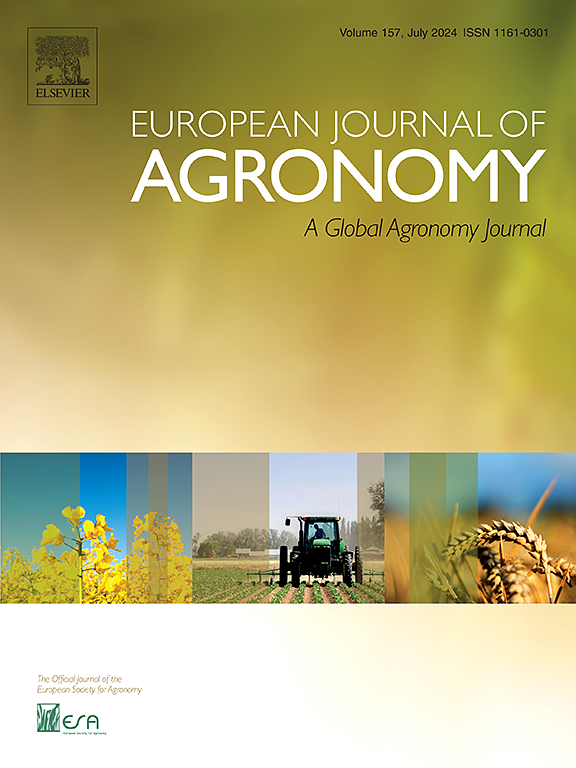基于多模态数据的小麦生长阶段识别方法
IF 4.5
1区 农林科学
Q1 AGRONOMY
引用次数: 0
摘要
准确识别作物生长阶段是实施有效栽培管理的重要基础。随着图像理解领域深度学习技术的发展,基于 RGB 图像的作物生长阶段智能实时识别研究受到了广泛关注。然而,作物形态特征在相邻生长阶段过渡期间的微小差异和高度相似性给准确识别带来了挑战。为解决这一问题,本研究提出了一种多尺度卷积神经网络模型,称为多尺度卷积神经网络-小麦(MSN-W),该模型利用多尺度卷积和注意力机制,增强了算法学习复杂特征的能力。该模型从冗余数据中提取关键信息,以识别复杂田间环境中的冬小麦生长阶段。实验结果表明,MSN-W 模型的识别准确率达到 97.6%,优于 VGG19、ResNet50、MobileNetV3 和 DenseNet 等典型卷积神经网络模型。在过渡时期,冠层形态特征高度相似且差异较小,为了进一步解决生长阶段识别困难的问题,本文引入了一种创新方法,即结合与小麦生长阶段相关的连续环境数据。通过提取这些特征并进行多模态协同推理,在 MSN-W 模型的基础上构建了一个基于多模态特征的小麦生长阶段识别模型,称为多模态网络-小麦(MMN-W)。实验结果表明,MMN-W 模型的识别准确率达到 98.5%,比 MSN-W 模型提高了 0.9%。MSN-W 和 MMN-W 模型都为观测小麦生长阶段提供了准确的方法,从而为冬小麦不同生长阶段的科学管理提供了支持。本文章由计算机程序翻译,如有差异,请以英文原文为准。
Wheat growth stage identification method based on multimodal data
Accurate identification of crop growth stages is a crucial basis for implementing effective cultivation management. With the development of deep learning techniques in image understanding, research on intelligent real-time recognition of crop growth stages based on RGB images has garnered significant attention. However, the small differences and high similarity in crop morphological characteristics during the transition between adjacent growth stages pose challenges for accurate identification. To address this issue, this study proposes a multi-scale convolutional neural network model, termed MultiScalNet-Wheat (MSN-W), which enhances the algorithm's ability to learn complex features by utilizing multi-scale convolution and attention mechanisms. This model extracts key information from redundant data to identify winter wheat growth stages in complex field environments. Experimental results show that the MSN-W model achieves a recognition accuracy of 97.6 %, outperforming typical convolutional neural network models such as VGG19, ResNet50, MobileNetV3, and DenseNet. To further address the difficulty in recognizing growth stages during transition periods, where canopy morphological features are highly similar and show small differences, this paper introduces an innovative approach by incorporating sequential environmental data related to wheat growth stages. By extracting these features and performing multi-modal collaborative inference, a multi-modal feature-based wheat growth stage recognition model, termed MultiModalNet-Wheat (MMN-W), is constructed on the basis of the MSN-W model. Experimental results indicate that the MMN-W model achieves a recognition accuracy of 98.5 %, improving by 0.9 % over the MSN-W model. Both the MSN-W and MMN-W models provide accurate methods for observing wheat growth stages, thereby supporting the scientific management of winter wheat at different growth stages.
求助全文
通过发布文献求助,成功后即可免费获取论文全文。
去求助
来源期刊

European Journal of Agronomy
农林科学-农艺学
CiteScore
8.30
自引率
7.70%
发文量
187
审稿时长
4.5 months
期刊介绍:
The European Journal of Agronomy, the official journal of the European Society for Agronomy, publishes original research papers reporting experimental and theoretical contributions to field-based agronomy and crop science. The journal will consider research at the field level for agricultural, horticultural and tree crops, that uses comprehensive and explanatory approaches. The EJA covers the following topics:
crop physiology
crop production and management including irrigation, fertilization and soil management
agroclimatology and modelling
plant-soil relationships
crop quality and post-harvest physiology
farming and cropping systems
agroecosystems and the environment
crop-weed interactions and management
organic farming
horticultural crops
papers from the European Society for Agronomy bi-annual meetings
In determining the suitability of submitted articles for publication, particular scrutiny is placed on the degree of novelty and significance of the research and the extent to which it adds to existing knowledge in agronomy.
 求助内容:
求助内容: 应助结果提醒方式:
应助结果提醒方式:


